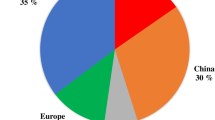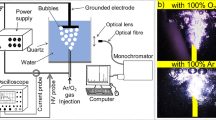Abstract
This study investigated the reactive dissolution of nitric oxide (NO) and nitrogen dioxide (NO2) mixtures in deionized water. The dissolution study was carried out in a flat surface type gas–liquid reaction chamber utilizing a gas flow-pattern resembling plasma jets which are often used in biomedical applications. The concentration of NO and NO2 in the gas mixtures was varied in a broad range by oxidizing up to 800 ppm of nitric oxide in Ar carrier gas with variable amount of ozone. The production of nitrite (NO2−) and nitrate (NO3−) in the water was proportional to treatment time up to 50 min. The concentration of NO3− was a power function of gas phase NO2 while the concentration of NO2− increased approximately linearly with gas phase NO2. The formation of NO2− and NO3− could be described by reactions between dissolved NO2 and NO in the water while the production rate was determined by diffusion-limited mass transport of nitrogen oxides to the bulk of the liquid. At higher NO2 concentrations, the formation of dinitrogen tetraoxide (N2O4) increased the formation rate of NO2− and NO3−. The identified mass transport limitation by diffusion suggests that convection of water created by the gas jet is insufficient and dissolution of nitrogen oxides can be increased by additional mixing. In respect of practical applications, the ratio of NO2− /NO3− in water could be varied from 0.8 to 5.3 with treatment time and gas phase NO2 and NO concentrations.





Similar content being viewed by others
Data Availability
The data that support the findings of this study are available from the corresponding author upon reasonable request.
References
Kaushik NK, Ghimire B, Li Y et al (2018) Biological and medical applications of plasma-activated media, water and solutions. Biol Chem 400:39–62. https://doi.org/10.1515/hsz-2018-0226
Bradu C, Kutasi K, Magureanu M et al (2020) Reactive nitrogen species in plasma-activated water: generation, chemistry and application in agriculture. J Phys D Appl Phys 53:223001. https://doi.org/10.1088/1361-6463/ab795a
Von Woedtke T, Emmert S, Metelmann HR et al (2020) Perspectives on cold atmospheric plasma (CAP) applications in medicine. Phys Plasmas 27:070601. https://doi.org/10.1063/5.0008093
Ranieri P, Sponsel N, Kizer J et al (2020) Plasma agriculture: review from the perspective of the plant and its ecosystem. Plasma Process Polym 18:e2000162. https://doi.org/10.1002/ppap.202000162
Park DP, Davis K, Gilani S et al (2013) Reactive nitrogen species produced in water by non-equilibrium plasma increase plant growth rate and nutritional yield. Curr Appl Phys 13:S19–S29. https://doi.org/10.1016/j.cap.2012.12.019
Lukes P, Dolezalova E, Sisrova I, Clupek M (2014) Aqueous-phase chemistry and bactericidal effects from an air discharge plasma in contact with water: evidence for the formation of peroxynitrite through a pseudo-second-order post-discharge reaction of H2O2 and HNO2. Plasma Sour Sci Technol 23:015019. https://doi.org/10.1088/0963-0252/23/1/015019
Komiyama H, Inoue H (1978) Reaction and transport of nitrogen oxides in nitrous acid solutions. J Chem Eng Jpn 11:25–32. https://doi.org/10.1252/jcej.11.25
Beligni MV, Lamattina L (2000) Nitric oxide stimulates seed germination and de-etiolation, and inhibits hypocotyl elongation, three light-inducible responses in plants. Planta 210:215–221. https://doi.org/10.1007/PL00008128
Neill SJ, Desikan R, Hancock JT (2003) Nitric oxide signalling in plants. New Phytol 159:11–35. https://doi.org/10.1046/j.1469-8137.2003.00804.x
Cui D, Yin Y, Wang J et al (2019) Research on the physio-biochemical mechanism of non-thermal plasma-regulated seed germination and early seedling development in Arabidopsis. Front Plant Sci 10:1–12. https://doi.org/10.3389/fpls.2019.01322
Komiyama H, Inoue H (1980) Absorption of nitrogen oxides into water. Chem Eng Sci 35:154–161
Aoki M, Tanaka H, Komiyama H, Inoue H (1982) Simultaneous absorption of NO and NO2 into alkaline solutions. J Chem Eng Jpn 15:362–367
Lee YN, Schwartz SE (1981) Reaction kinetics of nitrogen dioxide with liquid water at low partial pressure. J Phys Chem 85:840–848. https://doi.org/10.1021/j150607a022
Lee YN, Schwartz SE (1981) Evaluation of the rate of uptake of nitrogen dioxide by atmospheric and surface liquid water. J Geophys Res 86:11971–11983. https://doi.org/10.1029/JC086iC12p11971
Schwartz SE, White WH (1983) Kinetics of reactive dissolution of nitrogen oxides into aqueous solution. Adv Environ Sci Technol 12:1–116
Lewis RS, Deen WM (1994) Kinetics of the reaction of nitric oxide with oxygen in aqueous solutions. Chem Res Toxicol 7:568–574. https://doi.org/10.1038/209706a0
Thomas D, Vanderschuren J (1998) Effect of temperature on NOx absorption into nitric acid solutions containing hydrogen peroxide. Ind Eng Chem Res 37:4418–4423. https://doi.org/10.1016/j.cep.2007.08.014
Machala Z, Tarabová B, Sersenová D et al (2019) Chemical and antibacterial effects of plasma activated water: correlation with gaseous and aqueous reactive oxygen and nitrogen species, plasma sources and air flow conditions. J Phys D Appl Phys 52:034002. https://doi.org/10.1088/1361-6463/aae807
Jirásek V, Lukeš P (2019) Formation of reactive chlorine species in saline solution treated by non-equilibrium atmospheric pressure He/O2 plasma jet. Plasma Sour Sci Technol 28:035015. https://doi.org/10.1088/1361-6595/ab0930
Uchida G, Kawabata K, Ito T et al (2017) Development of a non-equilibrium 60 MHz plasma jet with a long discharge plume. J Appl Phys 122:033301. https://doi.org/10.1063/1.4993715
Uchida G, Nakajima A, Ito T et al (2016) Effects of nonthermal plasma jet irradiation on the selective production of H2O2 and NO2- in liquid water. J Appl Phys 120:203302. https://doi.org/10.1063/1.4968568
Schmidt-Bleker A, Bansemer R, Reuter S, Weltmann KD (2016) How to produce an NOx- instead of Ox-based chemistry with a cold atmospheric plasma jet. Plasma Process Polym 13:1118–1125. https://doi.org/10.1002/ppap.201600062
Jablonowski H, Schmidt-Bleker A, Weltmann KD et al (2018) Non-touching plasma-liquid interaction-where is aqueous nitric oxide generated? Phys Chem Chem Phys 20:25387–25398. https://doi.org/10.1039/c8cp02412j
Noori H, Raud J, Talviste R, Jõgi I (2021) Water dissolution of nitrogen oxides produced by ozone oxidation of nitric-oxide Water dissolution of nitrogen oxides produced by ozone oxidation of nitric oxide. Ozone Sci Eng 43:284–294
Hansen L, Schmidt-Bleker A, Bansemer R et al (2018) Influence of a liquid surface on the NOx production of a cold atmospheric pressure plasma jet. J Phys D Appl Phys 51:474002. https://doi.org/10.1088/1361-6463/aad6f0
Iséni S, Reuter S, Weltmann KD (2014) NO2 dynamics of an Ar/Air plasma jet investigated by in situ quantum cascade laser spectroscopy at atmospheric pressure. J Phys D Appl Phys 47:075203. https://doi.org/10.1088/0022-3727/47/7/075203
Van Gessel AFH, Hrycak B, Jasiński M et al (2013) Temperature and NO density measurements by LIF and OES on an atmospheric pressure plasma jet. J Phys D Appl Phys 46:095201. https://doi.org/10.1088/0022-3727/46/9/095201
Van Gessel AFH, Alards KMJ, Bruggeman PJ (2013) NO production in an RF plasma jet at atmospheric pressure. J Phys D Appl Phys 46:265202. https://doi.org/10.1088/0022-3727/46/26/265202
Van Ham BTJ, Hofmann S, Brandenburg R, Bruggeman PJ (2014) In situ absolute air, O3 and NO densities in the effluent of a cold RF argon atmospheric pressure plasma jet obtained by molecular beam mass spectrometry. J Phys D Appl Phys 47:224013. https://doi.org/10.1088/0022-3727/47/22/224013
Preissing P, Korolov I, Schulze J et al (2020) Three-dimensional density distributions of NO in the effluent of the COST reference microplasma jet operated in He/N2/O2. Plasma Sources Sci Technol 29:125001. https://doi.org/10.1088/1361-6595/abbd86
Hao X, Mattson AM, Edelblute CM et al (2014) Nitric oxide generation with an air operated non-thermal plasma jet and associated microbial inactivation mechanisms. Plasma Process Polym 11:1044–1056. https://doi.org/10.1002/ppap.201300187
Brubaker TR, Ishikawa K, Kondo H et al (2019) Liquid dynamics in response to an impinging low-temperature plasma jet. J Phys D Appl Phys 52:075203. https://doi.org/10.1088/1361-6463/aaf460
Semenov IL, Weltmann KD, Loffhagen D (2019) Modelling of the transport phenomena for an atmospheric-pressure plasma jet in contact with liquid. J Phys D Appl Phys 52:315203. https://doi.org/10.1088/1361-6463/ab208e
Raud S, Raud J, Jõgi I et al (2021) The production of plasma activated water in controlled ambient gases and its impact on cancer cell viability. Plasma Chem Plasma Process 41:1381–1395. https://doi.org/10.1007/s11090-021-10183-6
Jõgi I, Levoll E, Raud J (2016) Plasma oxidation of NO in O2:N2 mixtures: the importance of back-reaction. Chem Eng J 301:149–157. https://doi.org/10.1016/j.cej.2016.04.057
Jõgi I (2019) The effect of TiO2 catalyst on the NO reduction by barrier discharge in nitrogen. Plasma Chem Plasma Process 39:1191–1202. https://doi.org/10.1007/s11090-019-10001-0
Manley TC (1943) The electric characteristics of the ozonator discharge. J Electrochem Soc 84:83–96
Jõgi I, Bichevin V, Laan M et al (2009) NO conversion by dielectric barrier discharge and TiO2 catalyst: effect of oxygen. Plasma Chem Plasma Process 29:205–215. https://doi.org/10.1007/s11090-009-9171-5
Jõgi I, Erme K, Haljaste A, Laan M (2013) Oxidation of nitrogen oxide in hybrid plasma-catalytic reactors based on DBD and Fe2O3. Eur Phys J Appl Phys 61:24305. https://doi.org/10.1051/epjap/2012120421
Jõgi I, Haljaste A, Laan M (2014) Hybrid TiO2 based plasma-catalytic reactors for the removal of hazardous gasses. Surf Coat Technol 242:195–199. https://doi.org/10.1016/j.surfcoat.2013.10.016
Talviste R, Raud S, Jõgi I et al (2019) Investigation of a He micro plasma-jet utilized for treatment of prostate cancer cells. Plasma Res Express 1:045002. https://doi.org/10.1088/2516-1067/ab4ea9
Erme K, Jõgi I (2019) Metal oxides as catalysts and adsorbents in ozone oxidation of NOx. Environ Sci Technol 53:5266–5271. https://doi.org/10.1021/acs.est.8b07307
Jõgi I, Erme K, Levoll E et al (2018) Plasma and catalyst for the oxidation of NOx. Plasma Sour Sci Technol 27:35001. https://doi.org/10.1088/1361-6595/aaae3c
Jõgi I, Erme K, Raud J, Laan M (2016) Oxidation of NO by ozone in the presence of TiO2 catalyst. Fuel 173:45–54. https://doi.org/10.1016/j.fuel.2016.01.039
Decanini E, Nardini G, Paglianti A (2000) Absorption of nitrogen oxides in columns equipped with low-pressure drops structured packings. Ind Eng Chem Res 39:5003–5011. https://doi.org/10.1021/ie000270q
Janda M, Hensel K, Tóth P et al (2021) The role of HNO2 in the generation of plasma-activated water by air transient spark discharge. Appl Sci 11:7053. https://doi.org/10.3390/app11157053
Karlsson HT (1984) Exact solution to NO2 absorption. J Chem Eng Jpn 17:214–215
Sander R (2015) Compilation of Henry’s law constants (version 4.0) for water as solvent. Atmos Chem Phys 15:4399–4981. https://doi.org/10.5194/acp-15-4399-2015
Oehmigen K, Hoder T, Wilke C et al (2011) Volume effects of atmospheric-pressure plasma in liquids. IEEE Trans Plasma Sci 39:2646–2647. https://doi.org/10.1109/TPS.2011.2158242
Kondeti VSSK, Bruggeman PJ (2021) The interaction of an atmospheric pressure plasma jet with liquid water: dimple dynamics and its impact on crystal violet decomposition. J Phys D Appl Phys 54:045204. https://doi.org/10.1088/1361-6463/abbeb5
Adeney W, Becker HG (1920) The determination of the rate of solution of atmospehric nitrogen and oxygen by water-part II. Philos Mag J Sci 44:386–404
Tachibana K, Oh JS, Nakamura T (2020) Oxidation processes of NO for production of reactive nitrogen species in plasma activated water. J Phys D Appl Phys 53:385202. https://doi.org/10.1088/1361-6463/ab91eb
Acknowledgements
This work was supported by Estonian Research Council project PUT1432. This publication is based upon work from COST Action CA19110—PlAgri, supported by COST (European Cooperation in Science and Technology-www.cost.eu).
Author information
Authors and Affiliations
Corresponding author
Additional information
Publisher's Note
Springer Nature remains neutral with regard to jurisdictional claims in published maps and institutional affiliations.
Supplementary Information
Below is the link to the electronic supplementary material.
Rights and permissions
About this article
Cite this article
Talviste, R., Jõgi, I., Raud, S. et al. Nitrite and Nitrate Production by NO and NO2 Dissolution in Water Utilizing Plasma Jet Resembling Gas Flow Pattern. Plasma Chem Plasma Process 42, 1101–1114 (2022). https://doi.org/10.1007/s11090-022-10270-2
Received:
Accepted:
Published:
Issue Date:
DOI: https://doi.org/10.1007/s11090-022-10270-2




